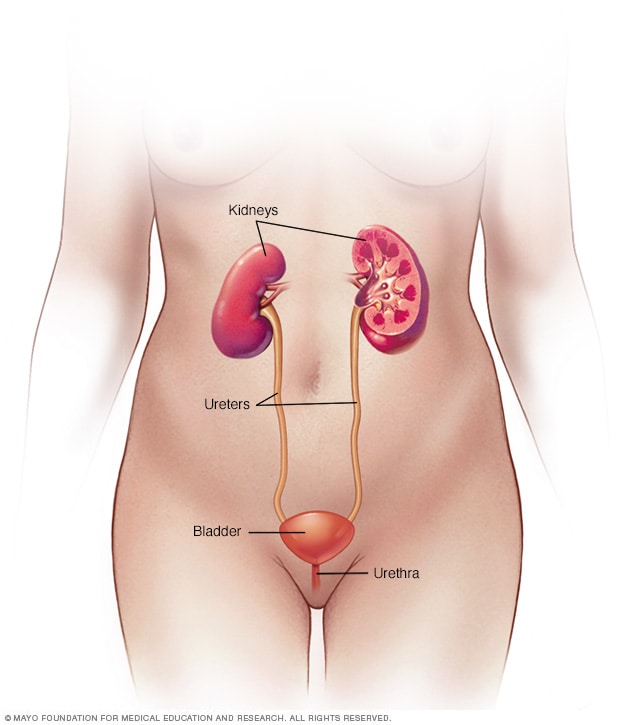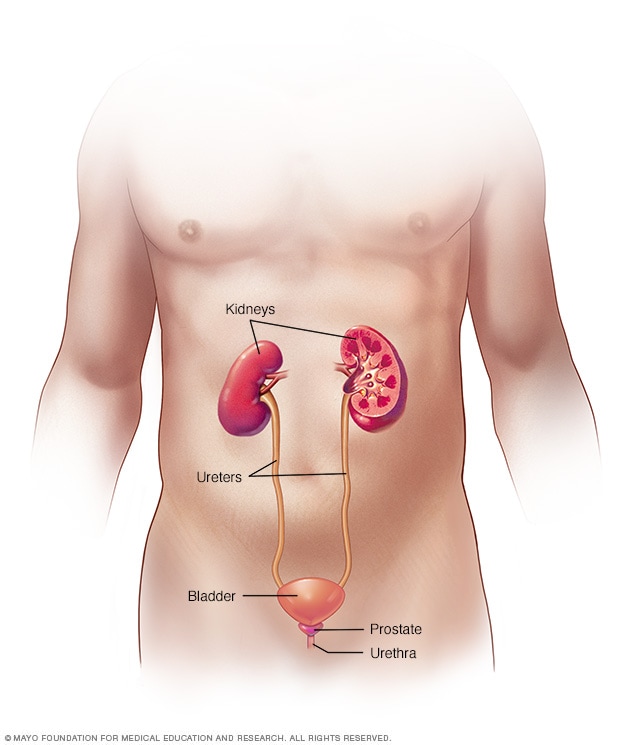Ureteral obstruction
Ureteral obstruction
overview
Female urinary system

Female urinary system
Your urinary system includes the kidneys, ureters, bladder, and urethra. The urinary system removes waste products from the body through urine. The kidneys are located in the back of the upper abdomen. They filter waste and fluid from the blood and produce urine. Urine travels from the kidneys through narrow tubes to the bladder. These tubes are called ureters. The bladder stores urine until it is time to urinate. Urine leaves the body through another small tube called the urethra.
Male urinary system

Male urinary system
Your urinary system includes the kidneys, ureters, bladder, and urethra. The urinary system removes waste products from the body through urine. The kidneys are located in the back of the upper abdomen. They filter waste and fluid from the blood and produce urine. Urine travels from the kidneys through narrow tubes to the bladder. These tubes are called ureters. The bladder stores urine until it is time to urinate. Urine leaves the body through another small tube called the urethra.
A ureteral obstruction is a blockage in one or both tubes (ureters) that carry urine from the kidneys to the bladder. Ureteral obstruction can be cured. However, if left untreated, symptoms can quickly progress from mild – pain, fever and infection – to severe – loss of kidney function, sepsis and death.
Ureteral obstruction is fairly common. Because it is treatable, serious complications are rare.
Symptoms
A ureteral obstruction may have no signs or symptoms. Signs and symptoms depend on where the obstruction occurs, whether it is partial or complete, how quickly it develops, and whether it affects one or both kidneys.
Signs and symptoms can include:
- Schmerzen
- Veränderungen der Urinproduktion (Urinausscheidung)
- Schwierigkeiten beim Wasserlassen
- Blut im Urin
- Harnwegsinfektion
- Bluthochdruck (Hypertonie)
When to go to the doctor?
Make an appointment with your doctor if you have signs and symptoms that worry you.
See a doctor if you notice any of the following:
- Schmerzen, die so stark sind, dass Sie nicht stillsitzen oder eine bequeme Position finden können
- Schmerzen begleitet von Übelkeit und Erbrechen
- Schmerzen begleitet von Fieber und Schüttelfrost
- Blut im Urin
- Schwierigkeiten beim Wasserlassen
Causes
Double ureter and ureterocele

Double ureter and ureterocele
A duplicated ureter occurs when two ureters form on the same kidney. A ureterocele is a small bulge in the ureter, usually at the end closest to the bladder. Both conditions can lead to ureteral obstruction.
Different types of ureteral obstructions have different causes, some of which are present at birth (congenital). They include:
- Ein zweiter (duplizierter) Harnleiter. Dieser häufige angeborene Zustand führt dazu, dass sich zwei Harnleiter auf derselben Niere bilden. Der zweite Harnleiter kann vollständig oder nur teilweise entwickelt sein. Wenn einer der Harnleiter nicht richtig funktioniert, kann Urin in die Niere zurückfließen und Schäden verursachen.
- Eine Blockade (Verstopfung) an der Stelle, an der der Harnleiter mit der Niere oder Blase verbunden ist. Dadurch wird der Urinfluss verhindert. Eine Blockade an der Stelle, an der sich Harnleiter und Niere treffen (Harnleiter-Becken-Übergang), kann dazu führen, dass die Niere anschwillt und schließlich ihre Funktion einstellt. Dieser Zustand kann angeboren sein oder sich mit typischem kindlichem Wachstum entwickeln, aus einer Verletzung oder Narbenbildung resultieren oder sich in seltenen Fällen aus einem Tumor entwickeln. Eine Blockade an der Stelle, an der sich Harnleiter und Blase treffen (ureterovesikaler Übergang), kann dazu führen, dass sich Urin in die Nieren zurückstaut.
- Ureterozele. Wenn ein Harnleiter zu eng ist und den Urin nicht vollständig abfließen lässt, kann sich eine winzige Vorwölbung im Harnleiter (Ureterozele) entwickeln. Wenn sich eine Ureterozele entwickelt, befindet sie sich normalerweise in dem Abschnitt des Harnleiters, der der Blase am nächsten liegt. Dies kann den Urinfluss blockieren und dazu führen, dass sich Urin in die Niere zurückstaut, was möglicherweise zu Nierenschäden führt.
- Retroperitoneale Fibrose. Diese seltene Erkrankung tritt auf, wenn fibröses Gewebe im Bereich hinter dem Bauch wächst. Die Fasern können als Folge von Krebstumoren oder durch die Einnahme bestimmter Medikamente zur Behandlung von Migräne wachsen. Die Fasern umschließen und blockieren die Harnleiter, wodurch der Urin in die Nieren zurückfließt.
Other possible causes
Various causes inside (intrinsic) or outside (extrinsic) the ureter can lead to ureteral obstruction, including:
- Nierensteine
- Krebsartige und gutartige Tumore
- Blutgerinnsel
- Vergrößerte Lymphknoten
- Inneres Gewebewachstum, wie Endometriose bei Frauen
- Langfristige Schwellung der Harnleiterwand, in der Regel aufgrund von Krankheiten wie Tuberkulose oder einer Parasiteninfektion namens Bilharziose
Complications
Ureteral obstruction can lead to urinary tract infections and kidney damage, which can be irreversible.
Treatment of ureteral obstruction
Sources:
- Zeidel ML, et al. Klinische Manifestationen und Diagnose von Harnwegsobstruktion und Hydronephrose. https://www.uptodate.com/contents/search. Abgerufen am 1. Oktober 2021.
- Yu ASL, et al., Hrsg. Obstruktion der Harnwege. In: Brenner & Rector’s The Kidney. 11. Aufl. Elsevier; 2020. https://www.clinicalkey.com. Abgerufen am 9. Oktober 2021.
- Obstruktive Uropathie. Merck Manual Professional-Version. https://www.merckmanuals.com/professional/genitourinary-disorders/obstructive-uropathy/obstructive-uropathy#. Abgerufen am 1. Oktober 2021.
- Fragen Sie MayoExpert. Obstruktion des ureteropelvinen Überganges (Erwachsener). Mayo-Klinik; 2021.
- Gargollo PC (Expertenmeinung). Mayo-Klinik. 28. Oktober 2021.
- Tabib C, et al. Management- und Behandlungsoptionen bei bösartiger Harnleiterobstruktion. Internationale Zeitschrift für Urologie. 2020; doi:10.1111/iju.14235.
- Braswell Pickering EA. Allscripts EPSi. Mayo-Klinik. 15. Juli 2021.

 Suche
Suche
 Mein Konto
Mein Konto